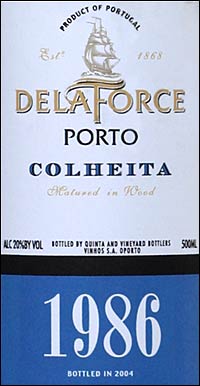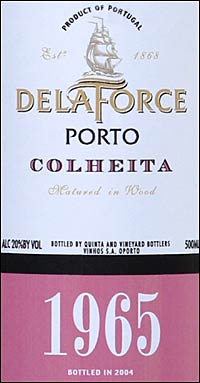Dark, powerful Vintage Ports claim the lion's share of attention from wine connoisseurs, and therefore it's easy to forget that those elite wines are not the only Ports worthy of acclaim. The tawny Port category encompasses great wines that are readier to drink upon release than Vintage Ports are, easier to handle, and every bit as delicious, in a kinder, gentler style.
 Most tawny Ports are blends of wines from various years, but some, such as this Colheita from 1986, are from a single vintage. ("Colheita" is the Portuguese word for "vintage.") Blended or not, tawnies age much longer in wood than Vintage Ports do, with the effect of lightening their color, tannin and fruitiness. Delaforce's 1986 Colheita aged for 19 years before being bottled in 2005, while a typical Vintage Port wood-ages only two years before bottling, and LBV (late bottled vintage) Ports age four to six years in wood.
Most tawny Ports are blends of wines from various years, but some, such as this Colheita from 1986, are from a single vintage. ("Colheita" is the Portuguese word for "vintage.") Blended or not, tawnies age much longer in wood than Vintage Ports do, with the effect of lightening their color, tannin and fruitiness. Delaforce's 1986 Colheita aged for 19 years before being bottled in 2005, while a typical Vintage Port wood-ages only two years before bottling, and LBV (late bottled vintage) Ports age four to six years in wood.
The house of Delaforce is a long-time specialist in tawny Ports, and Colheitas in particular. Along with Niepoort, it is one of the two Port houses most famous for these wines. Today, Delaforce is part of The Fladgate Partnership, which also includes Taylor Fladgate, Fonseca and Croft. Delaforce's wines typically have a delicacy that's particularly complimentary to the tawny style.
If you engage lovers of tawny Port in a discussion about the ideal age for drinking a tawny, you're likely to find some disagreement. Blended tawnies may carry four designations of age, to represent the average age of wines in the blend: 10 years old, 20 years old, 30 years old, or more than 40 years old. The youngest wines are redder and fruitier, and the oldest are paler, nuttier, and less fruity. Some people prefer the former; some, the latter; and some, those in the middle. In its degree of fruitiness, the 1986 Delaforce Colheita is comparable to a 20-year-old tawny, but it has a bit more complexity of flavor, offering hints of sandalwood and spice, dried fig, toasted almond and bitter orange peel.
This wine is a bit dryer than most tawnies and it retains a slight grip of delicate tannin on the rear palate that reinforces that dryish impression. But the texture is not at all dry, suggesting sheer silk on the tongue.
 Serve this wine very slightly chilled, with nuts, dried fruits, soft cheeses, or pumpkin pie. It doesn't need decanting, because its sediment has settled out in the cask before bottling. It will keep for several weeks in the refrigerator after opening.
Serve this wine very slightly chilled, with nuts, dried fruits, soft cheeses, or pumpkin pie. It doesn't need decanting, because its sediment has settled out in the cask before bottling. It will keep for several weeks in the refrigerator after opening.
Delaforce has also recently released three older Colheitas. The 1965 (about $114/ 500 ml) is terrific, more delicate than the 1986 and yet also more concentrated. The 1952 and 1944 cost about $214 and $358 respectively for 500 ml bottles. Of course the experience, as they say, is priceless.
Outstanding: 91